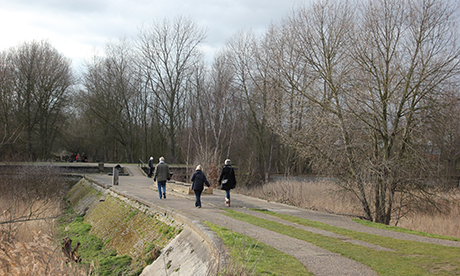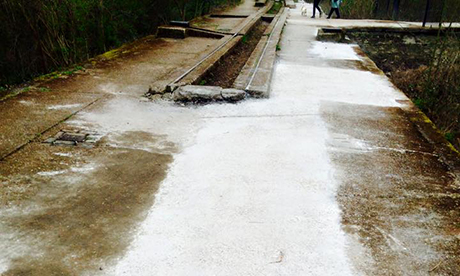Alarm raised over ‘hazardous’ run-off from fresh concrete laid in nature reserve

Paths above the Middlesex Filter Beds in the Lea Valley nature reserve. Photograph: Matthew Black (Creative Commons)
A local environmentalist is up in arms over concreting works which took place above a “locally sensitive” watercourse in the Lea Valley nature reserve.
Private building contractor Henderson and Taylor was appointed by Lea Valley Regional Park Authority to replace the 100 year-old concrete on the Middlesex Filter Beds following a successful civil litigation claim when a member of public tripped on one of the paths.
Environmentalist and local resident Alistair Siddons noticed the works had taken place when he discovered damage to the trees, concrete spilling over into vegetation and a layer of white cement dust on the pathways.
The run-off from pressure washing newly-laid concrete has a high levels of alkaline, which means it could have an adverse impact on the plants and fragile aquatic ecosystems if it runs into the reedbeds below.
Mr Siddons told the Hackney Citizen he was “alarmed” to find concreting taking place at a such a “sensitive” site and said he was shocked that there had been no communication with the public or park rangers – who were unaware the work was taking place.
He said: “As soon as I saw the way concrete had been applied on the path between the reed beds, I was alarmed by the potential for the highly-alkaline dust and run-off to cause harm to flora and fauna.”
“I’ve been surprised by the Park Authority’s refusal to accept that fresh concrete and run-off is hazardous to fragile ecosystems.”
When asked for comment on the hazards of handling fresh concrete, Dr Andrea Sella, Professor in material and inorganic chemistry at University College London (UCL) said: “You’ve only got to cycle behind a concrete truck to see a very visible warning that concrete is highly alkaline and causes serious burns.
“We need 1,000 to 10,000 gallons of water for every gallon of wash-out to get the water back to neutral where it started. A tadpole will simply turn white in this stuff, very quickly.
“In slow-moving or standing water like reed beds, there’s far more of a concern as it will take longer for the alkaline hot-spots to be diluted to their starting level.”
Flouting guidelines
In an e-mail to Mr Siddons seen by the Hackney Citizen, the Environment Agency (EA) said: “It doesn’t look good for the Parks Authority to sanction works that may have an adverse environmental impact, even if that impact is minor and restricted to a small area.”
An EA spokesperson said: “We have written to their [Lea Valley Park Authority’s] contract manager to advise on the need to manage the runoff from such works in
protected areas.”
“Work was carried out on concrete footpaths that had deteriorated. As part of this process, water jetting created the splashing of vegetation and small quantities of the residue going into the former filter beds.
“There was no impact on the Lee Canal River Lee flood relief channel.”
Impact ‘negligible’
Lee Valley Regional Park Authority insists that the concrete would have “negligible impact.”
Alex Farris, Green Space Manager, said: “A risk assessment was undertaken prior to the start of the works. A minimal amount of concrete dust and water ran from the path. As a precaution, we advised the contractors to be extra vigilant.
“As guardians of the open spaces in Lee Valley Regional Park, we would like to assure visitors that we would not have proceeded with the works if they were to have a negative impact on wildlife.”
Mr Siddons said: “If mean what we say when we claim to care for the environment, local environmental trusteeship matters. The big picture is the sum of all these local habitats.”

